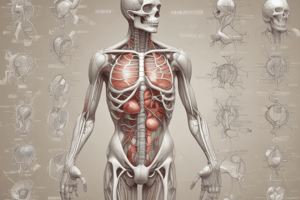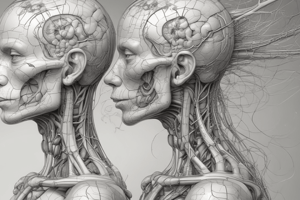Podcast
Questions and Answers
What is the primary role of an effector in the body?
What is the primary role of an effector in the body?
- To carry out the necessary response to correct imbalances (correct)
- To initiate feedback loops
- To transmit signals from the brain to organs
- To detect changes in the internal environment
Which of the following is an example of a positive feedback mechanism?
Which of the following is an example of a positive feedback mechanism?
- Regulating blood glucose levels
- Sweating to cool the body down
- Blood pressure regulation
- Oxytocin release during childbirth (correct)
What characterizes the feedback loop during childbirth?
What characterizes the feedback loop during childbirth?
- It prevents excessive uterine contractions
- It requires multiple hormones to function
- It involves an amplified response to the original stimulus (correct)
- It stops immediately after the first contraction
Which of the following statements best describes negative feedback?
Which of the following statements best describes negative feedback?
What term describes the change that initiates a feedback loop in the body?
What term describes the change that initiates a feedback loop in the body?
What is the primary focus of pathology?
What is the primary focus of pathology?
Which level of organization is described as a structure composed of at least two types of tissues?
Which level of organization is described as a structure composed of at least two types of tissues?
What does pharmacology study?
What does pharmacology study?
Which statement accurately describes physiology?
Which statement accurately describes physiology?
What is the basic unit of life according to the levels of organization?
What is the basic unit of life according to the levels of organization?
Which of the following best describes pathophysiology?
Which of the following best describes pathophysiology?
At which level of organization do all body systems work together?
At which level of organization do all body systems work together?
Which of the following is an example of the tissue level of organization?
Which of the following is an example of the tissue level of organization?
What is the primary role of homeostasis in the body?
What is the primary role of homeostasis in the body?
Which type of feedback loop tends to restore balance in the body?
Which type of feedback loop tends to restore balance in the body?
What is the effect of a positive feedback loop on a system?
What is the effect of a positive feedback loop on a system?
In the context of body temperature regulation, what role do sweat glands play?
In the context of body temperature regulation, what role do sweat glands play?
Which component of a feedback system is responsible for processing information?
Which component of a feedback system is responsible for processing information?
What happens when the body temperature drops below normal levels?
What happens when the body temperature drops below normal levels?
What is a common characteristic of negative feedback loops in the human body?
What is a common characteristic of negative feedback loops in the human body?
Which of the following is NOT a key component of feedback systems?
Which of the following is NOT a key component of feedback systems?
Study Notes
Definitions
- Anatomy studies the physical structures of organisms
- Physiology studies how the body’s systems function
- Pathology studies disease processes and their effects
- Pathophysiology focuses on how disease affects normal physiological functions
- Pharmacology studies drugs and their effects on the body
Levels of Organization in the Human Body
- Cellular level: The basic unit of life, all body functions depend on cells.
- Tissue level: Groups of similar cells performing a specific function.
- Organ level: A structure composed of at least two types of tissues that perform a specific function.
- Organismal level: The entire human body, composed of all systems working together.
Systems of the Human Body
- Integumentary: Skin, hair, nails - protection
- Musculoskeletal: Bones, muscles, joints - movement and support
- Circulatory: Heart, blood vessels - blood transport
- Respiratory: Lungs, airways - gas exchange
- Digestive: Stomach, intestines - food breakdown
- Nervous: Brain, spinal cord, nerves - communication and control
- Endocrine: Glands - hormone production
- Urinary: Kidneys, bladder - waste removal
- Reproductive: Male and female organs - reproduction
Homeostasis & Feedback Systems
- Homeostasis: The body's ability to maintain a stable internal environment despite external changes.
- Feedback systems: Control mechanisms that regulate homeostasis.
Components of Feedback Systems
- Receptor: Detects changes in the environment.
- Control Center: Processes information and makes decisions.
- Effector: Carries out the response.
Types of Feedback Loops
- Positive feedback loops: Response enhances the original condition.
- Negative feedback loops: Response counteracts or antagonizes the condition. This is more common in the body.
Example of Negative Feedback: Body Temperature Regulation
- Receptor: Detects changes in temperature (e.g., skin receptors).
- Control Center: Brain processes information and determines a response.
- Effector: Sweat glands cool the body down, muscles shiver to generate heat.
Example of Positive Feedback: Childbirth (Labor)
- Stimulus: Pressure on the cervix during labor.
- Amplified Response: Oxytocin release increases contractions.
- Eventual Outcome: The process continues until birth.
Studying That Suits You
Use AI to generate personalized quizzes and flashcards to suit your learning preferences.
Related Documents
Description
Explore the foundational concepts of human anatomy and physiology in this quiz. Covering levels of organization and systems of the human body, this quiz tests your understanding of how structures and functions are interrelated. Ideal for students studying health sciences.




